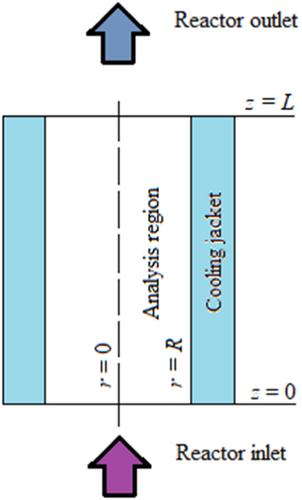下载PDF
{"title":"Exploring tubular steady-state laminar flow reactors with orthogonal collocation","authors":"André Von-Held Soares, Lizandro de Sousa Santos, Housam Binous, Abdullah A. Shaikh, Ahmed Bellagi","doi":"10.1002/cae.22795","DOIUrl":null,"url":null,"abstract":"<p>The laminar flow reactor (LFR) is one of the most comprehensive problems in chemical reaction engineering, as its modeling involves mass, heat, and momentum conservation equations coupled with chemical reaction rate equations. It is relatively easy to grasp its basic operation, but the solution of the problem is far from trivial. Although there are analytical solutions that simplify the problem, students and tutors must use efficient numerical strategies to appropriately solve some LFR problems. In the present investigation, we solve several different cases of two-dimensional cylindrical LFR, beginning with the isothermal case, as a benchmark. Calculations were performed using the Chebyshev orthogonal collocation technique by custom scripts in Scilab, Mathematica<sup>©</sup>, and Matlab®, and were compared with solutions available from the ECRE Version of COMSOL®, which was used as the reference, as well as available analytical solutions in the literature. After analyzing the case of the isothermal LFR with Newtonian fluid, we explored non-Newtonian fluids, including Carreau and Bingham fluids, whose LFR results are not available in the preceding literature. For Newtonian fluids, besides (a) the isothermal case, we also explore other three nonisothermal design cases: (b) cooling jacket with a fixed heat exchange coefficient at the wall, (c) adiabatic operation, (d) nonisothermal LFR with isothermal wall. Through a performance criterion, the different operation models are compared and we show that nonisothermal design cases perform better than the isothermal case. Computation times, for different scenarios, are quite short and taking 25 nodal points or more suffice for an accurate and timely solution of the more complex problem Case (b). The numerical modeling approach is useful from a pedagogical standpoint, as one can compare numerical results with classical assumptions, and progress from a more restrictive conceptual model (segregated flow) to an array of different kinds of operation with the LFR in which one needs to consider diffusion and temperature distribution.</p>","PeriodicalId":50643,"journal":{"name":"Computer Applications in Engineering Education","volume":"32 6","pages":""},"PeriodicalIF":2.0000,"publicationDate":"2024-09-07","publicationTypes":"Journal Article","fieldsOfStudy":null,"isOpenAccess":false,"openAccessPdf":"https://onlinelibrary.wiley.com/doi/epdf/10.1002/cae.22795","citationCount":"0","resultStr":null,"platform":"Semanticscholar","paperid":null,"PeriodicalName":"Computer Applications in Engineering Education","FirstCategoryId":"5","ListUrlMain":"https://onlinelibrary.wiley.com/doi/10.1002/cae.22795","RegionNum":3,"RegionCategory":"工程技术","ArticlePicture":[],"TitleCN":null,"AbstractTextCN":null,"PMCID":null,"EPubDate":"","PubModel":"","JCR":"Q3","JCRName":"COMPUTER SCIENCE, INTERDISCIPLINARY APPLICATIONS","Score":null,"Total":0}
引用次数: 0
引用
批量引用
Abstract
The laminar flow reactor (LFR) is one of the most comprehensive problems in chemical reaction engineering, as its modeling involves mass, heat, and momentum conservation equations coupled with chemical reaction rate equations. It is relatively easy to grasp its basic operation, but the solution of the problem is far from trivial. Although there are analytical solutions that simplify the problem, students and tutors must use efficient numerical strategies to appropriately solve some LFR problems. In the present investigation, we solve several different cases of two-dimensional cylindrical LFR, beginning with the isothermal case, as a benchmark. Calculations were performed using the Chebyshev orthogonal collocation technique by custom scripts in Scilab, Mathematica© , and Matlab®, and were compared with solutions available from the ECRE Version of COMSOL®, which was used as the reference, as well as available analytical solutions in the literature. After analyzing the case of the isothermal LFR with Newtonian fluid, we explored non-Newtonian fluids, including Carreau and Bingham fluids, whose LFR results are not available in the preceding literature. For Newtonian fluids, besides (a) the isothermal case, we also explore other three nonisothermal design cases: (b) cooling jacket with a fixed heat exchange coefficient at the wall, (c) adiabatic operation, (d) nonisothermal LFR with isothermal wall. Through a performance criterion, the different operation models are compared and we show that nonisothermal design cases perform better than the isothermal case. Computation times, for different scenarios, are quite short and taking 25 nodal points or more suffice for an accurate and timely solution of the more complex problem Case (b). The numerical modeling approach is useful from a pedagogical standpoint, as one can compare numerical results with classical assumptions, and progress from a more restrictive conceptual model (segregated flow) to an array of different kinds of operation with the LFR in which one needs to consider diffusion and temperature distribution.


